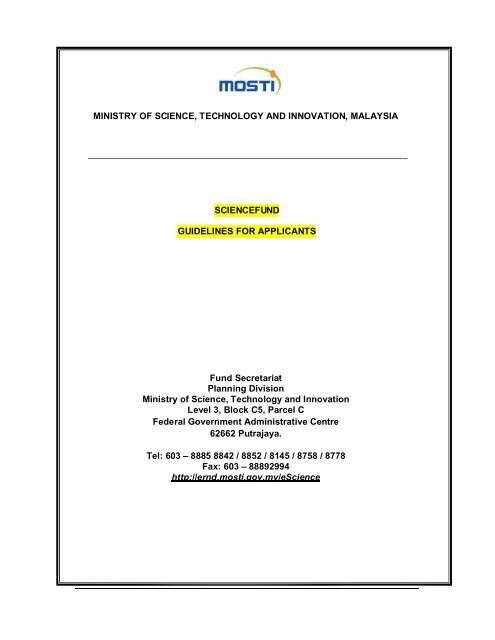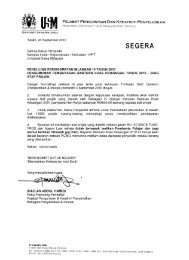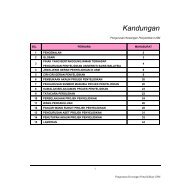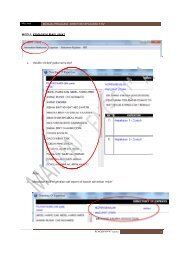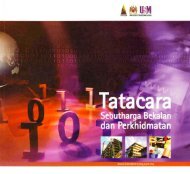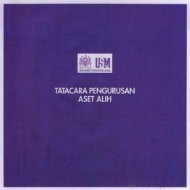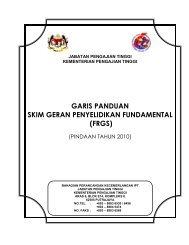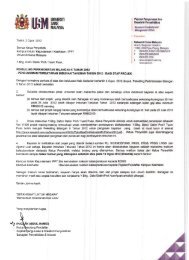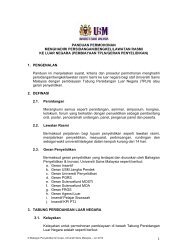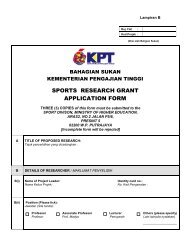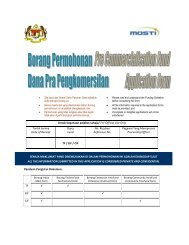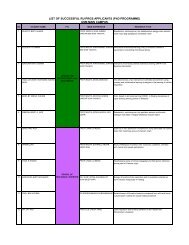MINISTRY OF SCIENCE, TECHNOLOGY AND INNOVATION ...
MINISTRY OF SCIENCE, TECHNOLOGY AND INNOVATION ...
MINISTRY OF SCIENCE, TECHNOLOGY AND INNOVATION ...
- No tags were found...
You also want an ePaper? Increase the reach of your titles
YUMPU automatically turns print PDFs into web optimized ePapers that Google loves.
<strong>MINISTRY</strong> <strong>OF</strong> <strong>SCIENCE</strong>, <strong>TECHNOLOGY</strong> <strong>AND</strong> <strong>INNOVATION</strong>, MALAYSIA<strong>SCIENCE</strong>FUNDGUIDELINES FOR APPLICANTSFund SecretariatPlanning DivisionMinistry of Science, Technology and InnovationLevel 3, Block C5, Parcel CFederal Government Administrative Centre62662 Putrajaya.Tel: 603 – 8885 8842 / 8852 / 8145 / 8758 / 8778Fax: 603 – 88892994http://ernd.mosti.gov.my/eScience
Table of ContentsPageChapter 1: Introduction to ScienceFund1.1 Definition Of ScienceFund 11.2 Objectives Of ScienceFund 11.3 Research Cluster (RC) And Priority Areas 11.4 Eligibility Criteria 11.5 Selection Criteria Of The Project 21.6 Location Of Research 21.7 Project Duration 21.8 Responsibility Of The Project Leader 31.9 Scope Of Funding 31.10 Variation In Project Costing 51.11 Non-Qualifying Project Activities 51.12 Project Extension 51.13 Notification Of Results 51.14 Acceptance Of Offer 61.15 ScienceFund Agreement 61.16 Ownership And Use Of R&D Equipment 61.17 Intellectual Property Rights 61.18 Publications 61.19 Monthly Financial Report 71.20 Change Of Project Leader 71.21 Transfers Of Grants Between Organisations 71.22 Termination 7Chapter 2: Project Application2.1 Application Process 82.2 Application Submission 82.3 Application Form 8Chapter 3: Project Evaluation3.1 Institutional Screening Committee 153.2 Technical And Financial Evaluation Committee At MOSTI 153.3 Fund Approval Committee 15Chapter 4: Allocation and Disbursement of Fund4.1 Quantum Of Funding 164.2 Initial Disbursement 164.3 Progress Payment 164.4 Institutional Financial Procedure 16Chapter 5: Project Implementation and Monitoring5.1 Project Implementation And Monitoring 175.2 Intellectual Property Rights 185.3 Expenditure Statements And Unexpended Grant 18Appendix I - Research Priority Areas 19-20Appendix II - Institution Category And Codes 21-24Appendix III - Fund Approval Committee 25
CHAPTER 1: INTRODUCTION TO <strong>SCIENCE</strong>FUND1.1 DEFINITION <strong>OF</strong> <strong>SCIENCE</strong>FUNDScienceFund is a grant provided by Government to carry out R&D projectsthat can contribute to the discovery of new ideas and the advancement ofknowledge in applied sciences, focusing on high impact and innovativeresearch.1.2 OBJECTIVES <strong>OF</strong> <strong>SCIENCE</strong>FUNDThe objectives of ScienceFund are:i. to support research that can lead to the innovation of products orprocesses for further development and commercialisation; and/orii. to generate new scientific knowledge and strengthen nationalresearch capacity and capability.1.3 RESEARCH PRIORITY AREASScienceFund focuses on the following areas:i. Life Sciences;ii. Computer Sciences and Information and Communication Technology(ICT);iii. Agriculture Sciences/ Agricultural Engineering;iv. Environmental Sciences;v. Advanced Materials Science;vi. Chemical Sciences;vii. Physical and Mathematical Sciences;viii. Engineering;ix. Medical and Health Sciences; andx. Social Sciences and Humanities.Project proposals eligible for consideration must fall under research priorityareas as in Appendix I: Table 1. Consideration for funding will also be givento identified Flagship Programmes as in Appendix I: Table 2.1.4 ELIGIBILITY CRITERIA1. This fund is open to all research scientists and engineers who areemployed on a permanent or contractual basis from the followingorganisations:i. Government Research Institutions (GRIs);ii. Government Science, Technology and Innovation (STI) Agencies; andiii. Public and Private Institutions of Higher Learning (IHL) with accreditedresearch programmes.1
Note:• Expatriates working under contract with any of the above institutionsare eligible to apply. However, the project must have a permanentMalaysian co-researcher from the same institution, well-versed with theproject, to ensure its completion in the event the expatriate’s contract isterminated.• The service of a contract researcher must be valid during the period ofresearch proposed and contractual documents must be furnished asproof of employment for the period.2. The following organisations are not eligible for ScienceFund:i. Private Research Institutions (PRIs) in the private sector;ii. Other department/agencies that carry out research under theirpurview; andiii. Research Institutions (RIs) with internal research funding such asCess Fund.Note: These organisations can participate by collaborating with theeligible institutions.3. Project proposals substantially similar to proposals submitted to anyother government funding agencies.4. Researchers can lead only one (1) project at any time. Researchershave to submit the End of Project Report (EPR), before submitting anew application.1.5 SELECTION CRITERIA <strong>OF</strong> THE PROJECT• Scientific and technical merit: The project must be scientificallysound, technically feasible with achievable milestones, and has thepotential for further development and commercialisation.• Research competence: The research team must have theknowledge and competency to carry out the research successfully tocompletion.• Innovativeness of the research.• High impact research: Clear and measureable expected output,outcome and impact in line with National Key Economic Areas /National Key Result Areas (NKEA/NKRA).1.6 LOCATION <strong>OF</strong> RESEARCHThe research project under ScienceFund must be carried out in Malaysia.1.7 PROJECT DURATIONThe project duration is up to 30 months.2
Note: Researchers/Institutions are obliged to provide additional and currentinformation from time to time upon written requests by MOSTI.1.8 RESPONSIBILITY <strong>OF</strong> THE PROJECT LEADERThe successful implementation of the project is the responsibility of theproject leader. Project leaders have to ensure that the projects are carried outeffectively to meet the specified objectives and milestones within the specifiedtimeframe and funding allocated.1.9 SCOPE <strong>OF</strong> FUNDINGScienceFund covers preliminary research leading to laboratory proof ofconcept or towards the development of new products or processes.The quantum of fund approved will be determined based on the merit of eachapplication.The funding can be utilised for the following categories:Wages and Allowances for Temporary and Contract Personnel (V11000)• Includes wages and allowances for temporary and contract personnelwho are directly engaged in the project. Only two (2) temporary orcontract personnel will be funded for each project.• The maximum wages/allowances for temporary or contract personnelare up to RM 2,500 per month/per head inclusive of deductions forSOCSO/EPF. The allocation cannot be used for tuition fees.Travel and Transportation (V21000)Includes travel and transportation expenses for domestic and overseas tripsdirectly related to the project.Overseas trips must meet the following criteria:• Only oral presentation at conferences or seminars on the findingsof the project;• When domestic facilities and expertise are inadequate to conducta portion of the research. However, the venue must be suitable interms of facilities, expertise and technology transfer;• The project leader or collaborator or team member is only allowed togo once for the duration of the project;• Travel is limited to economy class using the shortest direct routes byeither MAS or Air Asia except under extenuating circumstances;• The project leader or collaborator needs to send application for approvaland a copy of abstract/paper that is going to be presented to MOSTIbefore attending the conference; and• The allocation for travelling overseas must be budgeted for in theresearch proposal and must get prior approval from MOSTI.3
Expenses related to overseas trips will be funded up to a maximum of 15%of the total expenses of the project or RM15,000, whichever is less.Rentals (V24000)Only rental for building space, equipment, transportation and any other itemsdirectly related to the project can be included.Research Materials and Supplies (V26000)Only expenses for research materials and supplies directly related to theproject can be included.Note: Please provide detail of cost and quantity of items required. The grantwill not support utilities, books, stationeries and subscription to journals etc.Minor Modifications and Repairs (V28000)• Only expenses for minor modifications and repairs of laboratory,equipment or any other items directly related to the project can beincluded.• The maintenance costs of existing equipment used during the duration ofproject period can also be included.• The cost of maintenance of any equipment purchased will not be borneby ScienceFund after the project is completed.Special Services (V29000)• Only services directly related to the project such as:v consultancy – agreement/letter of intent must be submittedtogether with the project proposal;v payment for enumerators;v sample testing and analysis;v data processing;v patent registration, excluding–maintenance cost;v paper publications related to the project; andv registration fees for conference.• Engagement of foreign expert(s) will be considered on a case-by-casebasis.Note: All services under this category must be itemised.R&D Equipment and Accessories (V35000)• Justification for purchase of specialised equipment must be given. Projectleader will need to provide information on availability of such equipmentand why it cannot be used or shared.4
• Accessories needed include items tha t are neces sary to upgradethe capability of existing equipment directly related to the project.• Purchasing of equipment must be made in the first year. Purchasing ofpersonal computer, laptop, printer, server, scanners are not allowed.• Researchers are encouraged to share R&D equipment and avoidpurchasing of the same R&D equipment within the same ResearchInstitutions.• Funding for specialised equipment and accessories is up to a maximumof 40% of the total project expenses.Note: All specialised equipment/software directly related to the project mustbe itemised. Applicants need to provide justifications, specifications,quotations and estimated costs for such purchases.1.10 VARIATION IN PROJECT COSTINGVirement can only be done once throughout the project duration. For details,please refer to the V-series guidelines.Requests for virement to purchase new equipment in the last six months ofthe grant’s duration will not be entertained.1.11 NON-QUALIFYING PROJECT ACTIVITIESScientific and technical information services such as collecting, coding,recording, classifying, disseminating, translating, analysing, evaluating,bibliographic services, scientific and technical information extension advisoryservices and compilation of data, are excluded from the main activities of theproject except when they form an integral part of the project. In such a case,applicants must provide a statement indicating the research objectives towhich the data would contribute.1.12 PROJECT EXTENSION• Under certain circumstances, MOSTI may allow for extension of projectduration without additional funding.• Requests for project extensions must be made in writing via theinstitutional coordinator to the ScienceFund Secretariat for approval atleast three (3) months before the project completion date. Applicationsreceived after the project completion date, will not be considered.• The maximum extension given is up to 6 months including thesubmission of the End of Project Report.1.13 NOTIFICATION <strong>OF</strong> RESULTSThe results of applications will be notified, through the e-ScienceFundsystem to applicants within 7 working days after the convening of the FundApproval Committee Meeting.5
1.14 ACCEPTANCE <strong>OF</strong> <strong>OF</strong>FERApplicants must accept or decline the offer through the e-ScienceFundsystem within 14 days after notification.1.15 <strong>SCIENCE</strong>FUND AGREEMENTThe Heads of institutions are required to sign the ScienceFund Agreementwithin 30 working days upon acceptance of the approved projects, failingwhich MOSTI has the right to revoke the approval.1.16 OWNERSHIP <strong>AND</strong> USE <strong>OF</strong> R&D EQUIPMENTAll R&D equipment purchased under the grant must be recorded andtagged with the project number for monitoring and verification purposesand it belongs to the Institution.All R&D equipment purchased under the project must be maintained by theinstitution on conclusion of project. However, such equipment is not for thesole use of the institution, and must be made available to other researchorganisations as and when the need arises.1.17 INTELLECTUAL PROPERTY RIGHTSOwnership and management of IPR, royalties and any other form of feesreceived by the institution resulting from technology transfer, licensing oftechnology or any other form of commercialisation, shall be governed inaccordance with the terms and conditions outlined in the ScienceFundAgreement.1.18 PUBLICATIONSResearchers are encouraged to publish the results of their projects in localand renowned international publications only after all measures have beentaken to protect IPR generated from these projects.The contribution of MOSTI as the fund provider must be acknowledged atall times in all forms of publications.6
1.19 MONTHLY FINANCIAL REPORTEach institution is required to submit to MOSTI a Monthly Financial Reportof all approved projects in digital file (excel format) as shown in Table 1.Table 1: Summary of Monthly Financial Report1.20 CHANGE <strong>OF</strong> PROJECT LEADERIf a project leader resigns, retires or moves to another organisation, theinstitutional coordinator must immediately seek MOSTI’s approval for asuitable replacement within the same institute. The institutional coordinatormust ensure that the new project leader has the necessary expertise andexperience to lead the project.1.21 TRANSFERS <strong>OF</strong> GRANTS BETWEEN ORGANISATIONSIf the project leader wishes to transfer and bring along his/her project toanother organisation, it is allowed on condition that both parties agree to it bysigning a written agreement. The receiving organisation must be eligible to bea ScienceFund recipient. The project must be carried out in line with theoriginal scope approved.If either one party does not agree with the arrangement, MOSTI will terminatethe project and any unspent funding shall be returned to MOSTI.1.22 TERMINATIONProjects can be terminated based on the following:i. Any false reporting by the project leader;ii. Any misuse of the grant provided;iii. Non-performance in terms of progress;iv. Variation of scope of project without getting prior approval fromMOSTI;andv. No suitable project leader as replacement in the original recipientinstitute in cases as in 1.20.Any unspent funding shall be returned to MOSTI.7
CHAPTER 2: PROJECT APPLICATION2.1 APPLICATION PROCESSApplication for ScienceFund must be made online through the websitehttp://ernd.mosti.gov.my/eScience.Please refer to the eScienceFund User Manual for further instructions.2.2 APPLICATION SUBMISSIONApplication can be submitted throughout the year.2.3 APPLICATION FORMThis section of the Guidelines is for filling in the ScienceFund ApplicationForm.Project NumberThe project number is defined by the research cluster, institution’s category,institution’s name and serial number. It will automatically be generated bythe eScienceFund system once the proposal is submitted to MOSTI. Prior tothis submission, the system will allocate a temporary project number. Thecoding structure is as shown in Figure1.Figure 1: Coding Structure for Project NumberXX XX XX SFXXXXResearch Cluster Institution Category Institution Name Serial NumberNote: SF stands for ScienceFundExample: The project number 01-01-04-SF0001.01 – refers to the ICT cluster,01 – refers to Public Institution of Higher Learning04 – refers to UPMSF0001 – refers to the project serial number.For research cluster (RC) codes, please refer to Table 3, and theinstitution’s category and codes in Appendix II.8
Table 3: Research Cluster (RC) CodesCodeResearch Cluster01 Information and Communication Technology (ICT)02 Biotechnology03 Industrial Technology04 Sea to Space05 S&T CoreProject TitleThe title should be concise, clearly indicating the subject of the research andreflecting the key idea(s) of the project.Project ObjectivesThis section describes the measurable objectives of the project and definesthe expected results.Research BackgroundThe research background should cover the following elements:• The major issues and problems to be addressed by the research;• Research necessity and importance;• Variables and parameters of the research;• Hypothesis or theory, if any; and• Setting the limits or boundaries of the proposed research in order toprovide a clear focus.The literature review should be addressed in this section to meet therequirements below:• The application must be novel (should not "reinvent the wheel");• Demonstrates knowledge of the research problem;• Demonstrates understanding of the theoretical and research issues relatedto the research question; and• Critically analyses, integrates and synthesises the relevant literatureinformation.9
Socio-economic objectives (SEO)The socio-economic objectives (SEO) represent the purpose or sectoralbeneficiaries for which R&D activities are conducted. The SEO classificationallows for a systematic analysis of R&D funding at three different levels underthe SEO Divisions. There are 5 SEO Divisions, namely Defence, EconomicDevelopment, Society, Environment and Advancement of Knowledge.The appropriate divisions will determine the SEO Classification that bestdescribes the beneficiary group of the project from the Malaysian Researchand Development Classification, 5 th Edition or the latest edition. To classify theresearch project, please use the following definitions:• SEO CategoryThe SEO Category describes the sector of the national economy forwhich it will be the main beneficiary of the R&D being practised.• SEO GroupA sub-division under the SEO Category, which groups socio- economicactivities that have common characteristics.• SEO AreaA sub-division under the SEO Group, which represents a specificarea of research.Fields of Research (FOR)The fields of research (FOR) represent R&D activities classified according totheir scientific and academic disciplines. Please choose the FORclassification which most appropriately describes the scientific discipline beingpractised. Please select the FOR from the Malaysian Research andDevelopment Classification, 5 th Edition according to the following:• FOR CategoryA sub-division of scientific or academic disciplines.• FOR GroupA sub-division under the FOR Category.• FOR AreaA specific discipline within FOR Group which describes a science or atechnology area.10
Research Approach• Research MethodologyThe research methodology demonstrates how the applicant plans totackle the research problem. It should have details of the analyticaltechniques, research design and description of research activities.Specialised equipment, facilities and infrastructure, whether new orexisting, required for the project, should also be identified at this stage.The applicant should compare the methodology with alternativemethods and justify why the approach chosen is the most appropriate.• Project ActivitiesThe applicant should provide the work plan and the list of activitiesnecessary for the project to meet its objectives and , the transfer ofresearch results to customers / beneficiaries. It should also outline thesequence of the proposed activities and identify them in numberedstages, steps or phases.Research activities including all timelines must be reflected in the Ganttchart.• MilestonesMilestones must be tangible and quantifiable, marking significantphases of the project or completion of research activities that result in asignificant output.There must be at least 2 milestones per calendar year. The timing ofthe milestones must be reflected in the Gantt chart.Note: Literature review and report writing are not part of milestones.• Risk of the ProjectDescribe the factors that may cause delays or prevent successfulimplementation of the project as proposed. Give an estimate on thedegree of risk.Benefits of the Project• Output ExpectedvvvvvvvvMethod / techniqueDemonstrator / prototypeNew / improved product / deviceNew / improved processNew / improved softwareNew / improved materialNew / improved serviceIPR11
• Human Capital DevelopmentThe indicators are as follows:vvvvPost doctorateDoctorateMasterResearch staff with new specialisation• Economic ContributionThe indicators are as follows:vvvvvvSales of manufactured product / device / equipmentRoyalties from licensingRevenue from consultanciesCost savingsTime savingsOthers• Infrastructural contributionThe indicators are as follows:vvvvNew equipmentNew / improved facilityNew information networksOthersResearch CollaborationThe collaboration is in the form of sharing of expertise and researchfacilities, marketing opportunities and other related research resources.Details on the role of key collaborators should be provided. Such commitmentshould be substantiated by documentation proof such as memorandum ofagreement, letter of consent or any other form of agreement.For the project team, state all the collaborators involved based on their rolesand time allocated. The man-month of each of the project team member willbe automatically calculated based on the staff cost estimation worksheet.• Project ScheduleThe project schedule is automatically generated based on the researchactivities and milestone.12
• Staff Cost EstimationThe computation of daily rates for individual researchers or research staffis done according to the following formula:Where:Daily Rate = Emolument x Research Utilisation FactorAnnual Working Days• Emoluments include:v Annual basic salaryv EPF contributions by employerv Performance bonusesv Allowances• Annual working days are computed by deducting the totaldays in the year (365) with the following number of days:v Rest days (Saturday and Sunday)v Vacationv Public holidays• The research utilisation factor is calculated as follows:Research utilisation factor =Annual days on research projects and activitiesAnnual days on research projectsProject FundingThe research factor ensures that time spent on activities which are notproject specific (e.g. training, attendance of conferences, administrativetasks related to research proposals, recruiting of research staff, etc) isreflected in the daily rate.In addition to the ScienceFund, the applicants have to indicate and specify which ofthe following funding sources may provide funding for the project.• Domestic funding sources:vvvvOther Government Funding Schemes;Internal Funding;Industry sources;Others; please specify• International funding sources:vvvvWorld BankAsian Development Bank (ADB)United Nations Development Programme (UNDP)Others; please specify13
Summary of Relevant Past Research ProjectApplicants should provide a summary of past research, if any, which has relevanceto the proposed research.Contractual Obligations Under This ProjectApplicants must furnish (as attachment) documentation of any contractual obligationwith third parties.Ownership Of Intellectual Property RightsApplicants must indicate the organisation(s) that will own the intellectual propertyrights that may arise from this project.Ethical Clearance And Compliance To Other Related RegulationsProject Leaders must obtain and furnish (as attachment) a copy of ethical clearance,or clearance by its Institutional Biosafety Committee and submission of notification orsubmission of application for approval to the National Biosafety Board, and otherrelated regulations by the relevant authorities when necessary.14
CHAPTER 3: PROJECT EVALUATIONThe project evaluation consists of Institutional Screening, and Technical andFinancial Evaluation before it is submitted to Fund Approval Committee.3.1 INSTITUTIONAL SCREENING COMMITTEEAll applications are to be screened by the Institutional Screening Committeeto ensure that the applications conform to the ScienceFund requirements.The Institutional Screening Committee is required to assess various technicalaspects of the research proposal using the Institutional Screening Form. Itshould also ensure the project leader and research team are technicallycompetent, the project costs are fair, and there is optimal utilisation ofavailable research equipment and infrastructure.The Institutional Screening Committee must ensure that projects which involveexperimentation on humans or animals have obtained ethical clearance fromthe relevant authority. The Institutional Screening Report should be submittedonline via http://ernd.mosti.gov.my/eScience.3.2 TECHNICAL <strong>AND</strong> FINANCIAL EVALUATION COMMITTEE AT MOSTIThe Chairman and members of the Technical and Financial EvaluationCommittee are appointed by MOSTI. Members of this committee consist ofexperts from the public and the private sectors. However, additional experts,including international peer reviewers can be invited as and when necessary,to assist in the evaluation.All applications will be evaluated by the Technical and Financial EvaluationCommittee. The committee will study the proposals based on the merits of theresearch objectives, appropriateness of research methodology, ability ofresearchers and the cost effectiveness of the proposal.3.3 FUND APPROVAL COMMITTEEProjects evaluated by the Technical and Financial Evaluation Committee arethen submitted to the Fund Approval Committee for approval.The Fund Approval Committee is chaired by the Secretary-General of MOSTIand its members are as in Appendix III.Any decision made by the Fund Approval Committee is final.15
CHAPTER 4: ALLOCATION <strong>AND</strong> DISBURSEMENT <strong>OF</strong> FUND4.1 QUANTUM <strong>OF</strong> FUNDINGThe quantum for each project is up to RM500,000.00.4.2 INITIAL DISBURSEMENTThe project allocation for the first year allocation will be disbursed to therelevant institutions within one month of the return of the signedScienceFund Agreement to MOSTI.4.3 PROGRESS PAYMENTThe subsequent disbursements will be based on the milestone and financialachievements of the project.Process FlowFundApplicationInternalScreening(AV)Technical AndFinancialCommitteeEvaluationFund ApprovalCommitteeMeetingSite VisitMonitoringFundDisbursementApproval4.4 INSTITUTIONAL FINANCIAL PROCEDUREResearchers must abide by all financial rules and regulations of theinstitutions especially those pertaining to procurement, disbursement,appointment of research staff and intellectual property rights.16
CHAPTER 5: PROJECT IMPLEMENTATION <strong>AND</strong> MONITORING5.1 PROJECT IMPLEMENTATION <strong>AND</strong> MONITORING• All projects must be conducted in accordance with the terms andconditions outlined in the ScienceFund Agreement.• The project will be closely monitored to ensure that they are carried outsuccessfully. Researchers are required to submit the following reportsthrough the Institutional Coordinator via http://ernd.mosti.gov.my.• Progress Report (PR) must be submitted before 31 January and 31July each year. These reports will be used to monitor the progress ofthe project as well as determine the timing of the fund disbursements.This will take into account milestones achieved as well as 50%expenditure of the amount already disbursed. It is the project leader’sresponsibility to ensure that the correct and updated information relatedto the milestone achievement and expenditure are reported. Failure tosubmit the Progress Report is a serious omission that will result in thewithholding of further fund disbursement or possible termination ofproject. The report can also be used to apply for changes in timeline formilestone achievement and project schedule.• End of Project Report (EPR) should be submitted within three (3)months after project completion. All publications must acknowledgeMOSTI’s contribution as a fund provider. The End of Project Reportrequires the following information:v Direct outputs of the project;v Extent of achievement of the original project objectives;v Technology transfer and commercialisation approach;v Benefits of the project, particularly projectoutputs and organisational outcomes;v Assessment of the project team, research approach,project schedule and project costs; andv Sectoral/national impacts of the project.v Technical Report of the projectNote: The outcome of research under ScienceFund that has commercialpotential can be considered for additional funding under thePre-Commercialisation funding category.The reports will be reviewed by the panels at MOSTI through the:• Progress Assessment Report (PAR)• Outcome Assessment Report (OAR)MOSTI reserves the right to call for periodic information on progress or toconduct site visits even after the project has been completed.17
5.2 INTELLECTUAL PROPERTY RIGHTSResearchers shall disclose to the Government (MOSTI) in writing, of theexistence of the Project Intellectual Property not later than 60 days from theProject Completion Date.Incentive for Project Intellectual PropertyThe applicant may apply for the following incentives:• Incentive for disclosure of the Project Intellectual Property:RM500.00;• Incentive for filing of patent of the Project Intellectual Property:RM5,000.00; and• Incentive for granting of patent Project Intellectual Property:RM10,000.00.Payment of this incentive shall be on a one off basis.The institution shall pay:• the incentive for disclosure of the Project Intellectual Property upondisclosure of the Project Intellectual Property;• the incentive for filing of patent of the Project Intellectual Propertyupon receipt of the proof of patent filing of the Project IntellectualProperty; and• the incentive for granting of patent Project Intellectual Property uponreceipt of the proof of patent granted of the Project IntellectualProperty.5.3 EXPENDITURE STATEMENTS <strong>AND</strong> UNEXPENDED GRANTMOSTI reserves the right to require the Institution to complete and submit astatement of expenditure at any time during the course of a grant, or toprovide supplementary information in support of an interim or final expenditurestatement.The Institution shall return the unexpended grant to MOSTI within three (3)months after the completion of the project.18
No. RESEARCH AREAS PRIORITY AREAS12345• ENGINEERING<strong>SCIENCE</strong>S• ADVANCEDMATERIALS <strong>SCIENCE</strong>S• CHEMICAL <strong>SCIENCE</strong>S• ENGINEERING<strong>SCIENCE</strong>S• ENGINEERING<strong>SCIENCE</strong>S• PHYSICAL <strong>AND</strong>MATHEMATICAL<strong>SCIENCE</strong>S• LIFE <strong>SCIENCE</strong>S• AGRICULTURE<strong>SCIENCE</strong>S• ENGINEERING<strong>SCIENCE</strong>S• MEDICAL <strong>AND</strong>HEALTH <strong>SCIENCE</strong>STABLE 1: RESEARCH <strong>AND</strong> PRIORITY AREAS1 Cutting tool technology2 Design for Manufacturing and Assembly3 Flexible Manufacturing Systems4 Metrology SN: Including InstrumentationManufacturing such as Metrological Instrument5 Machining6 Laser machining7 Rapid prototyping and tooling8 Robotics and Mechatronics1 Biosensors2 Building and Construction Materials3 Fine Chemicals4 Green material5 Medical devices6 Microsphere technology7 Nano Materials8 Nano particle9 Nano photonic10 Nanoelectronics11 Nanotube12 Other Nanotechnology13 Quantum device14 Smart Materials1 Accelerator technology2 Ionising Radiation Technology3 Non-Destructive Testing4 Non-Ionising Radiation Technology5 Radiation Technology6 Reactor Technology1 Animal Biotechnology2 Animal Reproduction Biotechnology3 Biofeed4 Bioinformatics5 Bioprocessing6 Biosafety(Food)7 Cell Culture Technology8 Diagnostic Kits9 Enzyme Technology10 Feed and Nutrition11 Fermentation12 Functional Food13 Genomics14 Livestock Reproduction15 Microbial technology16 Product Recovery17 Risk Assessment18 Risk ManagementTransgenic Plant: Rice, Papaya, Banana and19Pineapple, Grain Maize20 Vaccine Development1 Biopharmaceuticals2 Obesity3 Nutraceuticals4 Drug Discovery5 Oncology6 Endocrinology7 Therapeutics8 Cardiology9 Respiratory Diseases10 Infectious/Communicable Diseases11 Gastroenterology78• ENGINEERING<strong>SCIENCE</strong>S• COMPUTER<strong>SCIENCE</strong>S& ICT• PHYSICAL <strong>AND</strong>MATHEMATICAL<strong>SCIENCE</strong>S• SOCIAL <strong>SCIENCE</strong>S<strong>AND</strong> HUMANITIES18 Monsoon System19 Oceanography Instrumentation20 Other Advancement of Marine SciencesKnowledge/Alternative energy Sources from thesea21 Sea Level Changes22 Seismology/Earthquake23 Solar Energy Technology24 Storm Water Management25 Tsunami26 Water Resources Management(Technology development for supplying cleanwater for rural communities)27 Wind1 Advance and Emerging Methods SN: Forecasting2 Antenna Technology (mitigation).)3 Biometrics Security System4 Broadband Communication5 Cloud Computing6 Digital Image processing System (Patternrecognition UAV platform development7 Digital Signal Processing8 Earth Observation System/Ground and SpaceStation9 Equipments SN/RFID10 Firewalls11 Grid Computing12 Intrusion Prevention System13 Malware, Worms and Viruses14 Micro Electro Mechanical System (MEMS)15 Mobile Network Technologies16 Other Communications n.e.c.SN: SecuredCommunication System17 Pattern Recognition and ImageRecognition/Imaging Processing and ComputerVision18 Processor Design. Geographic InformationSystem.19 Quantum Computing20 Radio Frequency Design (RF) Front-End21 Remote sensing and related technology22 Rocketry23 Safety Critical Software24 Satellite and Spacecraft System25 Satellite Communication Services (Bus).26 Security Protocols27 Security Services SN: Network Security28 Semantic technology29 Space sciences especially on Micro gravityexperiments Astronomy & Astrophysics30 Wireless Devices/Wireless Communication andTechnologies1 Community Development2 Environmental Economics3 Gender Studies4 Gerontology5 Policy studies6 Tourism Studies7 Transportation EconomicsAppendix I6• ENVIRONMENTAL<strong>SCIENCE</strong>S/ENGINEERING<strong>SCIENCE</strong>S1 Bio-Gas and Bio-Fuel2 Biomass Energy Technology e.g. Refuse-derivedFuel (RDF)3 Climatology4 Coastal Oceanography and Processes5 Disaster Management6 El Niño Southern Oscillation (ENSO)7 Fisheries Oceanography8 Hydro Power Technology9 Hydroinformatics /and Oceanographic DataManagement10 Land-Sea Interactions and Processes /Oceanatmosphereinteraction11 Marine Biodiversity, Conservation andManagement12 Marine Ecology13 Marine Geology14 Marine Pollution15 Marine Products Biotechnology16 Meteorological Oceanography /Natural marinehazards17 Meteorology19
Appendix ITABLE 2: FLAGSHIP PROGRAMMESNo. Flagship Programme1. Renewable Energy2. Advanced Manufacturing3. Electronics4. Wireless Sensor Network5. Predictive Analytics6. 3-Dimension Internet7. Space Technology8. Oceanography9. Meteorology10. Production System and Precision Agriculture11. Biosurveilance12. Tropical Emerging Infectious Diseases and Cancer13. Food Security and Food Biotechnology based Products20
Appendix IIINSTITUTION CATEGORY <strong>AND</strong> CODEPUBLIC INSTITUTIONS <strong>OF</strong> HIGHER LEARNING (CODE 01)InstitutionCodeInstitution Name01 UiTM (Universiti Teknologi MARA)02 UKM (Universiti Kebangsaan Malaysia)03 UM (Universiti Malaya)04 UPM (Universiti Putra Malaysia)05 USM (Universiti Sains Malaysia)06 UTM (Universiti Teknologi Malaysia)07 UUM (Universiti Utara Malaysia)08 UIAM (Universiti Islam Antarabangsa Malaysia)09 UNIMAS (Universiti Malaysia Sarawak)10 UMS (Universiti Malaysia Sabah)11 UPSI (Universiti Perguruan Sultan Idris)12 UMT (Universiti Malaysia Terengganu)13 UTHM (Universiti Tun Hussein Malaysia)14 UTeM (Universiti Teknikal Malaysia Melaka)15 UniMAP (Universiti Malaysia Perlis)16 UMP (Universiti Malaysia Pahang)17 USIM (Universiti Sains Islam Malaysia)18 UniSZA (Universiti Sultan Zainal Abidin)19 UPNM (Universiti Pertahanan Nasional Malaysia)20 UMK (Universiti Malaysia Kelantan)21
Appendix IIINSTITUTION CATEGORY <strong>AND</strong> CODEPRIVATE INSTITUTIONS <strong>OF</strong> HIGHER LEARNING (CODE 02)InstitutionCodeInstitution Name01 MMU (Multimedia University)02 UTP (Universiti Teknologi PETRONAS)03 UNITEN (Universiti Tenaga Nasional)04 UNIRAZAK (Universiti Tun Abdul Razak)05 MUST (Malaysia University of Science and Technology)06 KLIUC (Kuala Lumpur Infrastructure University Colege)07 CURTIN (Curtin University of Technology Sarawak)08 UNISEL (Universiti Industri Selangor)09 IMU (International Medical University)10 MONASH (Monash University Malaysia)11 UTAR (Universiti Tunku Abdul Rahman)12 NOTTINGHAM (University of Nottingham Malaysia Campus)13 UniKL (Universiti Kuala Lumpur)14 SUTS (Swinburne University of Technology, Sarawak Campus)15 MSU (Management and Science University)16 SUNWAY (Sunway University College)17 TATi (TATi University College)18 TAYLORS (Taylor's University)19 UNU-IIGH (United Nations University)22
Appendix IIINSTITUTION CATEGORY <strong>AND</strong> CODEPUBLIC RESEARCH INSTITUTIONS (CODE 03)InstitutionCodeInstitution Name01 ANM (Malaysian Nuclear Agency)02 SIRIM Berhad03 MACRES (Malaysian Centre for Remote Sensing)04 MIMOS Berhad05 TPM (Technology Park Malaysia Corporation Sdn. Bhd.)06 IPP (Institut Penyelidikan Perikanan)07 VRI (Veterinary Research Institute)08 MARDI (Malaysian Agricultural Research & Development)09 NAHRIM (National Hydraulic Research Institute of Malaysia)10 FRIM (Forest Research Institute of Malaysia)11 LGM (Lembaga Getah Malaysia)12 LKM (Lembaga Koko Malaysia)13 NIH (National Institute of Health)14STRIDE (Science & Technology Research Institute forDefence)15 PBM (Perbadanan Bioteknologi Melaka)16 SBC (Sarawak Biodiversity Centre)17 IKRAM (Kumpulan IKRAM Sdn. Bhd.)18 MRM (Majlis Rekabentuk Malaysia)19 Unit Makmal Penyelidikan Tanah Gambut Tropika20 IPHARM (Institut Farmaseutikal Dan Nutraseutikal Malaysia)21 CSM (Cyber Security Malaysia)23
Appendix IIINSTITUTION CATEGORY <strong>AND</strong> CODEGOVERNMENT STI AGENCIES (CODE 04)InstitutionCodeInstitution Name01 JTSB (Jabatan Pertanian Sabah)02 JISB (Jabatan Perikanan Sabah)03 JHSB (Jabatan Perkhidmatan Haiwan Sabah)04 JISK (Jabatan Perikanan Sarawak)05 JPS (Jabatan Pengairan & Saliran)06 JTSK (Jabatan Pertanian Sarawak)07 JMG (Jabatan Mineral & Geosains)08 FDPM (Forest Department of Peninsular Malaysia)09 JPSB (Jabatan Perhutanan Sabah)10 JKM (Jabatan Kimia Malaysia)11 Meteorologi (Jabatan Meteorologi Malaysia)12 ANGKASA (Agensi Angkasa Negara)13 ASM (Akademi Sains Malaysia)14 SFC (Sarawak Forestry Corporation)15 Jabatan Perhutanan Sarawak16 Institut Sukan Negara17 Jabatan Tenaga Manusia18 Institut Keselamatan Dan Kesihatan Pekerjaan Negara (NIOSH)19 ABI (Insititut Agro-Bioteknologi Malaysia)24
Appendix IIIFUND APPROVAL COMMITTEE1. Secretary General Chairperson2. Deputy Secretary General (Science) Member3. Deputy Secretary General (Policy) Member4. Senior Under Secretary (Planning) Member5. Under Secretary (Biotechnology) Member6. Under Secretary (Industry) Member7. Under Secretary (Sea to Space) Member8. Under Secretary (S&T Core) Member9. Under Secretary (ICT) Member10. Deputy Under Secretary (Fund Section) Secretary25


